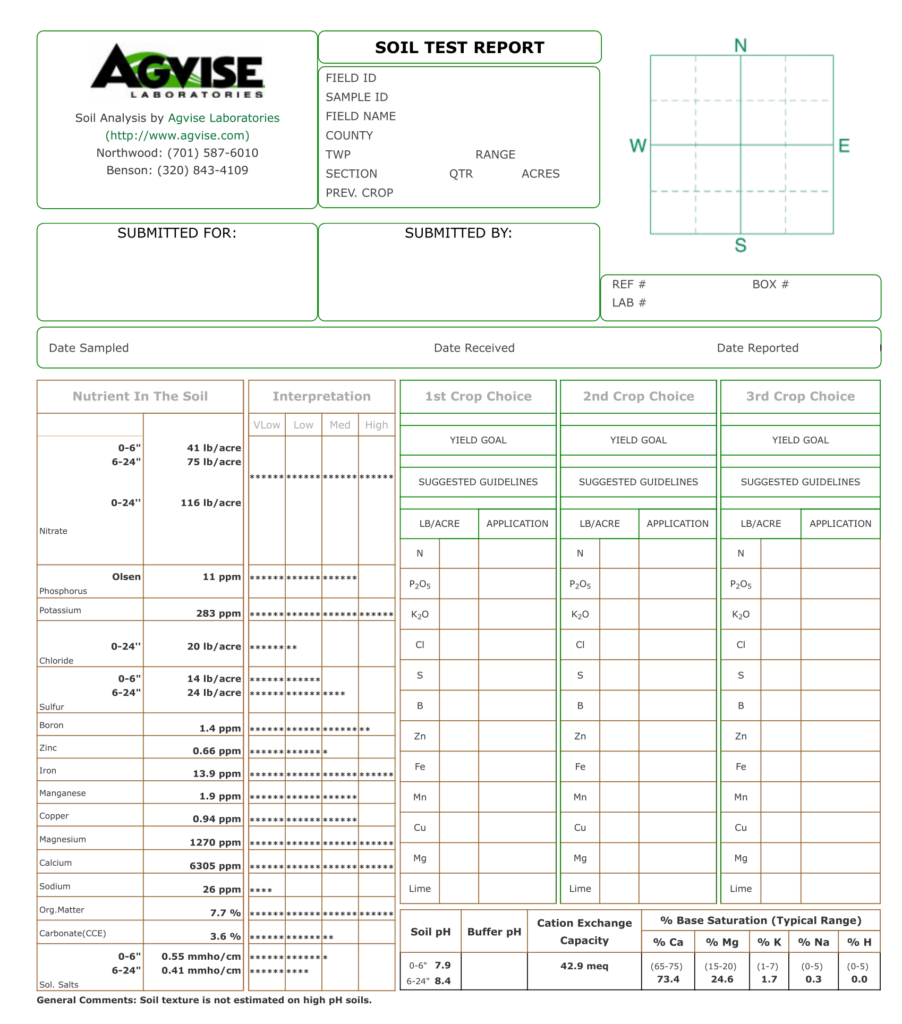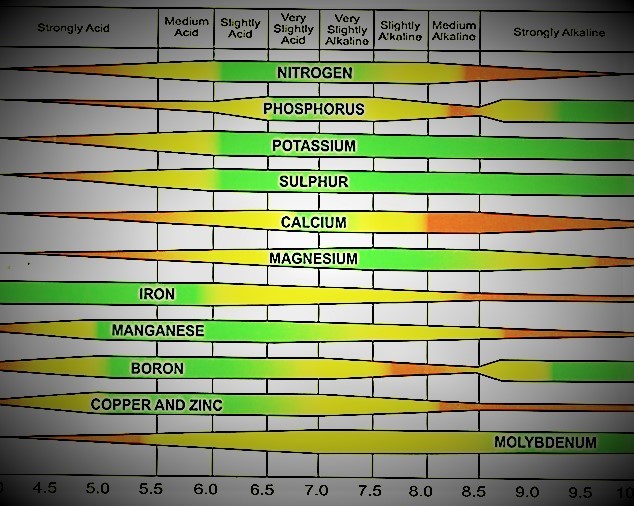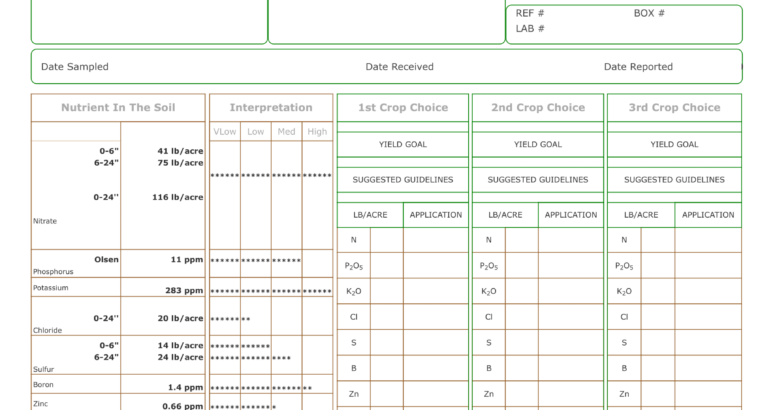Soil test – how to read soil analysis.
Soil tests: why are they necessary? How to read and interpret soil test results.
An agrochemical analysis of soils is carried out in order to:
Analyze whether the soil has sufficient plant nutrients in it;
Monitoring changes in the soil’s properties that influence plant development, growth, and growth rate;
To assess the nature and characteristics of the interactions between the soil and the applied fertilizers and substances from the atmosphere;
Determine how much fertilizer needs to be applied to the soil to get a planned yield.
The reason for the soil analysis and what does it involve?
Our main goal is to determine the main properties of the soil that can affect plant growth and development in some way. Several key properties should be analyzed, and we should determine how to change them to improve soil fertility and productivity.

First, let’s start with macronutrients, NPK + S.
N- even though Nitrogen is a common element in nature, many plants still lack it because they can only absorb specific forms of nitrogen.
Additionally, nitrogen is an essential element for the plant, being a part of proteins, DNA, and many other organic substances. The process of photosynthesis in plants is interrupted without Nitrogen, causing plants to dry out and die. Thus, so nitrogen is one of the most important factors in growing crops.
How can we determine the amount of nitrate in the soil available for the crop?
You can count 100% of N in 0-6″ depth plus 50% in 6-24″ depth plus OM x 3-15, depending on the region and previous crop. In our case, we will count 33lb+32lb+8 x 2-15 = 65lb + 16-120lb.
P – Phosphorus is also essential for plants because it is a component of many organic compounds and is also involved in the energy exchange in cells. In many soils, however, mobile forms of phosphorus are in short supply, resulting, in turn, in decreased enzyme activity, RNA formation, and cell division.
Hence, low phosphorus levels can retard plant growth, which, of course, affect yield. This is why determining the amount of mobile phosphorus in soil is vital.
The different types of tests available to determine the P availability are listed below.
Soil pH Methods
Acidic < 6.0 Bray 1, Mehlich 1, Mehlich 3, Water, IIP, and AER
Slightly acid to
slightly alkaline 6.0 to 7.2 Bray 1, Mehlich 1, Mehlich 3, Olsen, Water, IIP, and AER
Alkaline, calcareous > 7.2 Olsen, Water, IIP, and AER

In our case, the pH is 7.5-8, so the Olsen test was applied since it is the most efficient for the alkaline soil.
Some general recommendations for P application are;
Soil test ppm P2O5 lb/ac
0-7 35
7-10 30
10-13 25
13-15 15-20
15-18 10-15
18-25 10
25> 5-10
So, we have available 8ppm based on the soil test result. That means, in general, 30lb/ac should be applied to get a highest potential yield and build a P bank in the soil.
Keep in mind that organic matter will release some P. To get an accurate calculation of the amount of P2O5 needed for the planned yield, talk with your agronomist. Some crops require less P while others require a little more. In addition, climate, crop rotation, and soil chemistry might influence P activity in soil.
K – Potassium is contained in the cytoplasm, which largely determines its properties, and therefore affects every process within the cell.
Potassium is essential for water absorption, stomatal opening and closing, as well as both mitochondrial and chloroplast function. In addition, potassium starvation disrupts metabolism, including photosynthesis and respiration.
Thus, a sufficient amount of potassium in the soil makes plants more resistant to low and high temperatures, fungi, and other diseases, and also reduces the maturity time of plants.
Some general recommendations for K20 application are;
Soil test ppm K20 lb/ac
0 115-120
25 105-110
50 95-100
75 80-90
100 70-80
125 60-70
150 50—60
175 40-50
200 30-40
250 15-20
>250 o
In our case, we don’t need to add K2O.
S – Sulfur in plants is an important component of enzymes, as well as in protein formation. Although Sulfur is necessary in the very small amounts, deficiencies can threaten the health of plants and cause them to lose vitality.
Different crops need different amount of available S. For example, in our case we would need to ad about 25lb of sulfur to get 50 bu of canola, but don’t need extra sulfur to grow 70 bu of wheat.
Organic matter in soil test.
Organic matter – is an important indicator of soil fertility. It consists of organic residues and products that have already decomposed, called humus. OM contributes to the accumulation and retention of plant nutrients that pass into soil solution and can be absorbed by plants.
So, why is OM important?
- It improves microbial activity
- Reduces erosion potential
- Reduces soil compaction and improves dirt-water-air ratio (ideal soil has 50-25-25)
- Can hold and release anions like N,P,S,B,Zn better that other soil properties.
- Allows soil to warm up much faster in the spring.
- Improves soil structure
Some other facts about OM
Each percent of organic matter releases to the soil about:
- 2-20lb/ac of N
- 1-4 lb/ac of P
- 1-2 lb/ac of S
through mineralization.
In our case, we have 8% of OM. That means we can get about 16-160 lb/ac of N, 8-32 lb/ac of P and 8-16 lb/ac of S just from the soil.
How to increase OM.
Increases in organic matter can be achieved over time, but it is slow process and requires your commitment. There are e few mostly efficient ways to grow OM: use no-till technology or reduce tillage, include high residue crops with lots of roots in crop rotation, apply manure as often as possible, seed cover crops regularly, use biologically active products.
Micro elements in soil and their role for plant and yield.
Mn – Manganese
It is called “the element of life”. Mn is important for chlorophyl production. Additionally, manganese is essential for pollen germination, pollen tube growth and root elongation, as well as resistance to root pathogens.
Zn – Zinc
It is a key component of many enzymes involved in metabolic reactions in all plants. Zinc deficiency results in chlorosis, which is a yellowing of the veins between the tissue, while the veins remain green. Among other functions, zinc aids in germination, growth regulation and stem elongation.
Fe – Iron
Iron is a nutrien that all plants need in order to function well. Plants rely on iron for many vital functions, such as enzyme production, chlorophyll production, nitrogen fixing, and tissue growth and metabolism.
B – Borron
It is important for cell structure, hormones and moving sugar. It is beneficial for pollination and fruit and seed development.
Cu – Copper
Plants require Copper for many enzymatic activities and for the production of chlorophyll and seed. It is also important for lignin building ( lodging resistance) and seed size.
Cl – Chloride
It is essential for photosynthesis, osmotic adjustment, and suppression of plant disease. But high Chloride levels can cause toxicity issues in crops and reduce yields.
Mo – Molybdenum
Helps transform Nitrogen into amino acids and helps Nitrogen fixation in legumes. Molybdenum also aids in the conversion of inorganic phosphorus into organic forms in plants.
Co – Cobalt
It is a component of certain enzymes and helps seeds resist drought. In legumes, it is necessary to fix nitrogen by bacteria associated with legumes. It is also important for livestock health, so can be added to pasture.
Some tips;
Here is how you can determine your own fertilizer needs.
Determine your yield goal,
Calculate the total amount of nutrients required by your crop.
Subtract what is already in the soil.
Taking into consideration the amount of nutrients that will become available from organic matter.
Apply fertilizer to compensate nutrients removed from the soil based on planned yield.
Cation Exchange Capacity (CEC) in soil analysis.
Cation exchange capacity (CEC) of a soil is an indicator of its ability to hold positively charged ions. It is a soil property that directly influences soil structure stability, nutrient availability, soil pH levels, and the soil’s response to fertilizers and other soil improvements.
Soil CEC varies depending on clay percentage, clay type, pH and organic matter content.
It is considered that:
CEC >20 – “heave” clay soils
CEC <10 – “light” soils
CEC < 5 – sandy soils
Low CEC soils tend to deficient in potassium (K+), magnesium (Mg2+) and other cations, while high CEC soils retain more of these cations.
Base Saturation in soil test.
Base Saturation is one of the best ways to determine fertility balance in the soil.
It is shown as the ratio of the cations (Ca2+, Mg2+, K+, Na+ and H+ ) across the soil exchange sites divided by the total CEC and expressed as a percentage.
Some tips:
- Ca: 65% – 80%. Add lime if Calcium level is low.
- Mg: depending on CEC, if CEC <5,18% – 20%; if CEC >15, 12% – 14%. Add Mg if needed to increase. If Mg is high, improve drainage, add Ca, sometimes added Sulfur can help to reduce Mg
- K: 1% – 7%, best range is 4% – 8%
- Na: <1%, With a high Na, improve drainage, reduce high salt applications like manure, some kind of fertilizers.
- H: 2% – 10%
Soil pH in analysis.
Nutrient available & soil pH.

According to Wikipedia, Soil pH is a measure of the acidity or basicity (alkalinity) of a soil. Therefore, Soil pH is a key characteristic that you can use to make informative analysis both qualitative and quantitatively regarding soil characteristics.
Link to the video presentation https://www.youtube.com/watch?v=TiUU5A6vWls&t=113s
Some related articles to read, are Custom blends calculator, Weed Seedling Identification Guide.
There are a few factors in soil test you should pay attention in. Some of them are:
– Available macronutrients in your soil, NPK + S, and how they impact yield.
– Organic matter – is an important indicator of soil fertility.
– Micro elements in soil and their role for plant and yield.
– Cation exchange capacity (CEC) of a soil is an indicator of its ability to hold positively charged ions.
– Base Saturation is one of the best ways to determine fertility balance in the soil.
– Understand Soil pH.
You can find answer on all your questions about how to read a soil test in our article Soil test – how to read soil analysis.
The main goal of soil test is to determine the main properties of the soil that can affect plant growth and development in some way. Several key properties should be analyzed, and we should determine how to change them to improve soil fertility and productivity.
Soil test result give an understanding on what is in the soil, like;
Available macronutrients in your soil, NPK + S, and how they impact yield.
Organic matter – is an important indicator of soil fertility.
Micro elements in soil and their role for plant and yield.
Cation exchange capacity (CEC) of a soil is an indicator of its ability to hold positively charged ions.
Base Saturation is one of the best ways to determine fertility balance in the soil.
Understand Soil pH.
You can find answer on all your questions about how to read a soil test in our article Soil test – how to read soil analysis.
Soil tests shows main properties of the soil that can affect plant growth and development in some way, and help to determine how to change them to improve soil fertility and productivity.
Soil test result shows available in the soil;
Macronutrients, NPK + S
Organic matter – one of the important indicator of soil fertility.
Available Micro elements.
Cation exchange capacity (CEC).
Base Saturation, it is one of the best ways to determine fertility balance in the soil.
Soil pH.
You can find answer on all your questions about how to read a soil test in our article Soil test – how to read soil analysis.
There are a few factors in soil test you should pay attention in. Some of them are:
Available macronutrients in your soil, NPK + S, and how they impact yield.
Organic matter – is an important indicator of soil fertility.
Micro elements in soil and their role for plant and yield.
Cation exchange capacity (CEC) of a soil is an indicator of its ability to hold positively charged ions.
Base Saturation is one of the best ways to determine fertility balance in the soil.
Understand Soil pH.
You can find answer on all your questions about how to read a soil test in our article Soil test – how to read soil analysis.


